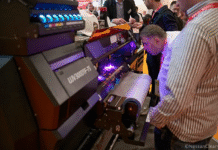
Many of the growing commercial printing businesses in the country are based on the partnerships of experienced professionals in the industry, who understand the value of quality and innovation. Often, they are able to establish the business from modest beginnings in a short period. Imaginative Colours in the Naraina Industrial Area of Delhi is one such business developed by Pradeep Rana and Manish Jain, who began their partnership just nine years ago.
Both partners are totally hands-on from prepress to binding and finishing, and within a decade they have been able to add a brand new RMGT 4-color press to their existing Heidelberg MOV 4-color. The compact press with economical power consumption fits into a space with restricted hight and gives Imaginative a large sheet size for high saturation work with tight registration. In terms of capacity, with a 25 x 36-inch press that can run at 15,000 sheets an hour, they have effectively added capacity which is two to three times what they had just a few months ago. “We are immensely satisfied with both the sheet size and the performance of the new RMGT machine, which optimize the plate, blanket and ink costs for commercial printing,” says Rana. In time, they will also be able to increase their turnover in alignment with their new overall capacity.
Direct to customer is key
In spite of the demonetization last year and the institution of GST this year, the two partners have not wavered much from their expansion plan. Although the purchase of RMGT slid from the previous financial year to the current one, it was ordered in March 2017 and installed in April. Since then it is producing quality work including difficult jobs and luxury brochures with heavy solids and small reverse type. Spot coating is a feature of many of their projects.
Customers of product brochures and full color books include Dabur, international non-profit institutions, DuPont, Hero and Jaguar. According to Rana, “The key to facing the market pressures of overcapacity and hypercompetitive prices is to avoid job work. We have succeeded because we print directly for customers who trust us on both quality and price and because we are here every day, for long hours and sometimes on holidays too. Moreover, the jobbers in this industry are going to face a tough time in the future. Only the ones serving clients directly are going to survive in the coming days.”
With consistent growth over the past decade, the two partners have plans for technology investments in postpress equipment going forward. They hope to move into their own premises as well. At a time when many bigger printers are challenged by the competitive market, it is apparent that the energy and focus of the new players can create a hands-on business model with a belief in technology that enables them to produce attractive print with added value.
Rana admits that although Imaginative Colours has been busy, the industry is facing challenges. “The market might witness a jump in the coming days but it has been stagnant for a long time,” he says. “There has been a huge difference in demand post GST. There was a lot of turbulence in the market soon after GST was implemented. The demand decreased suddenly and it was getting difficult for us to keep up with the changes brought about by the new tax regime. I think it will take some time for the prevailing situation to improve.”















